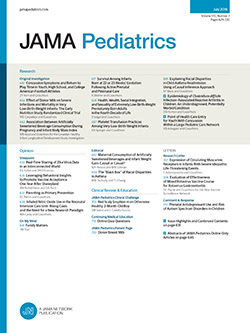急性镰状细胞痛急诊科和住院治疗阿片类药物的及时性
IF 18
1区 医学
Q1 PEDIATRICS
引用次数: 0
摘要
重要性急诊部(ED)及时给药阿片类药物治疗急性镰状细胞病(SCD)疼痛的指南缺乏明确的证据表明与减少住院率相关。目的评价儿童无并发症SCD疼痛发作时及时给予多种阿片类药物与住院治疗的关系。设计、环境和参与者这项多地点横断面研究使用了来自儿科急诊应用研究网络注册的数据。其中包括来自全美拥有综合SCD中心的儿童医院的12名儿科急诊科。纳入2019年1月1日至2021年12月31日期间在12个部位就诊的19岁以下无并发症SCD疼痛儿童的ED就诊。初步诊断代码用于识别SCD疼痛就诊;排除任何其他SCD并发症。初步数据分析从2024年4月至2025年4月进行,包括修订。修订后的分析在2025年5月至6月之间完成。暴露感兴趣的两种暴露如下:(1)从ED到达到第一次给药的时间(分为到达≤60分钟vs到达&; gt;60分钟)和(2)第一次和第二次给药的时间间隔(在单独的分析中分为≤30分钟vs &; gt;30分钟,≤45分钟vs &; gt;45分钟,≤60分钟vs &; gt;60分钟)。主要结局和措施主要结局是在急诊科就诊结束时住院。结果共纳入2538例患者(平均[SD]年龄12.0[5.0]岁,男性1293例[50.9%])。在9233例急诊科就诊中,5023例(54.4%)住院。单独评估阿片类药物首次给药的及时性与住院率降低相关(优势比[OR], 0.84; 95% CI, 0.75-0.95)。对7853例(85.1%)使用2剂或2剂以上阿片类药物的患者联合评价第一次和第二次阿片类药物给药的时效性,发现第一次阿片类药物的时效性与住院几率降低相关,即使第二次给药时间超过30分钟(or, 0.85; 95% CI, 0.74-0.98)或45分钟(or, 0.84; 95% CI, 0.72-0.97)。在30分钟(OR, 0.62; 95% CI, 0.52-0.75)、45分钟(OR, 0.70; 95% CI, 0.59-0.83)和60分钟(OR, 0.78; 95% CI, 0.67-0.92)间隔内及时给药联合第二次给药的住院几率最低。结论和相关性:这项横断面研究发现,及时接受阿片类药物与SCD疼痛住院率的降低有关。第一次在60分钟内注射,第二次在30分钟内注射,住院人数减少最多;然而,较长的第二次剂量持续时间与较少的住院率相关。本文章由计算机程序翻译,如有差异,请以英文原文为准。
Opioid Timeliness in the Emergency Department and Hospitalizations for Acute Sickle Cell Pain
ImportanceGuidelines for the timely emergency department (ED) administration of opioids for acute sickle cell disease (SCD) pain lack clear evidence showing associations with reduced hospitalizations.ObjectiveTo evaluate the associations between the timely administration of multiple opioid doses during uncomplicated SCD pain episodes in children and hospitalization.Design, Setting, and ParticipantsThis multisite cross-sectional study used data from the Pediatric Emergency Care Applied Research Network Registry. Included were 12 pediatric EDs from children’s hospitals with comprehensive SCD centers across the US. ED visits by children younger than 19 years with uncomplicated SCD pain at any of the 12 sites between January 1, 2019, and December 31, 2021, were included. Primary diagnosis codes were used to identify visits for SCD pain; visits with any other SCD complication were excluded. Initial data analysis was conducted from April 2024 to April 2025, including revisions. After-revision analyses were done between May and June of 2025.ExposuresThe 2 exposures of interest were as follows: (1) time from ED arrival to first opioid administration (dichotomized as ≤60 minutes of arrival vs >60 minutes from arrival) and (2) time interval between the first and the second opioid administration (dichotomized in separate analyses as ≤30 minutes vs >30 minutes, ≤45 minutes vs >45 minutes, and ≤60 minutes vs >60 minutes).Main Outcomes and MeasuresThe primary outcome was hospitalization at the end of an ED visit.ResultsA total of 2538 patients (mean [SD] age, 12.0 [5.0] years; 1293 male [50.9%]) were included in this study. Of 9233 ED visits, 5023 (54.4%) resulted in hospitalization. First-dose timeliness of opioid administration evaluated alone was associated with decreased hospitalizations (odds ratio [OR], 0.84; 95% CI, 0.75-0.95). Evaluating combined first- and second-dose timeliness of opioid administration for the 7853 visits (85.1%) with 2 or more opioid doses, first-opioid timeliness was associated with reduced odds of hospitalization, even when the second dose was outside 30 minutes (OR, 0.85; 95% CI, 0.74-0.98) or 45 minutes (OR, 0.84; 95% CI, 0.72-0.97). First-dose timeliness combined with a second dose within 30-minute (OR, 0.62; 95% CI, 0.52-0.75), 45-minute (OR, 0.70; 95% CI, 0.59-0.83), and 60-minute (OR, 0.78; 95% CI, 0.67-0.92) intervals achieved the lowest odds of hospitalization.Conclusions and RelevanceThis cross-sectional study found that timely receipt of opioids was associated with a reduction in hospitalizations for SCD pain. The largest decrease in hospitalization was achieved with the first dose within 60 minutes and the second dose within 30 minutes; however, longer second-dose durations were associated with reduced hospitalizations.
求助全文
通过发布文献求助,成功后即可免费获取论文全文。
去求助
来源期刊

JAMA Pediatrics
PEDIATRICS-
CiteScore
31.60
自引率
1.90%
发文量
357
期刊介绍:
JAMA Pediatrics, the oldest continuously published pediatric journal in the US since 1911, is an international peer-reviewed publication and a part of the JAMA Network. Published weekly online and in 12 issues annually, it garners over 8.4 million article views and downloads yearly. All research articles become freely accessible online after 12 months without any author fees, and through the WHO's HINARI program, the online version is accessible to institutions in developing countries.
With a focus on advancing the health of infants, children, and adolescents, JAMA Pediatrics serves as a platform for discussing crucial issues and policies in child and adolescent health care. Leveraging the latest technology, it ensures timely access to information for its readers worldwide.
 求助内容:
求助内容: 应助结果提醒方式:
应助结果提醒方式:


